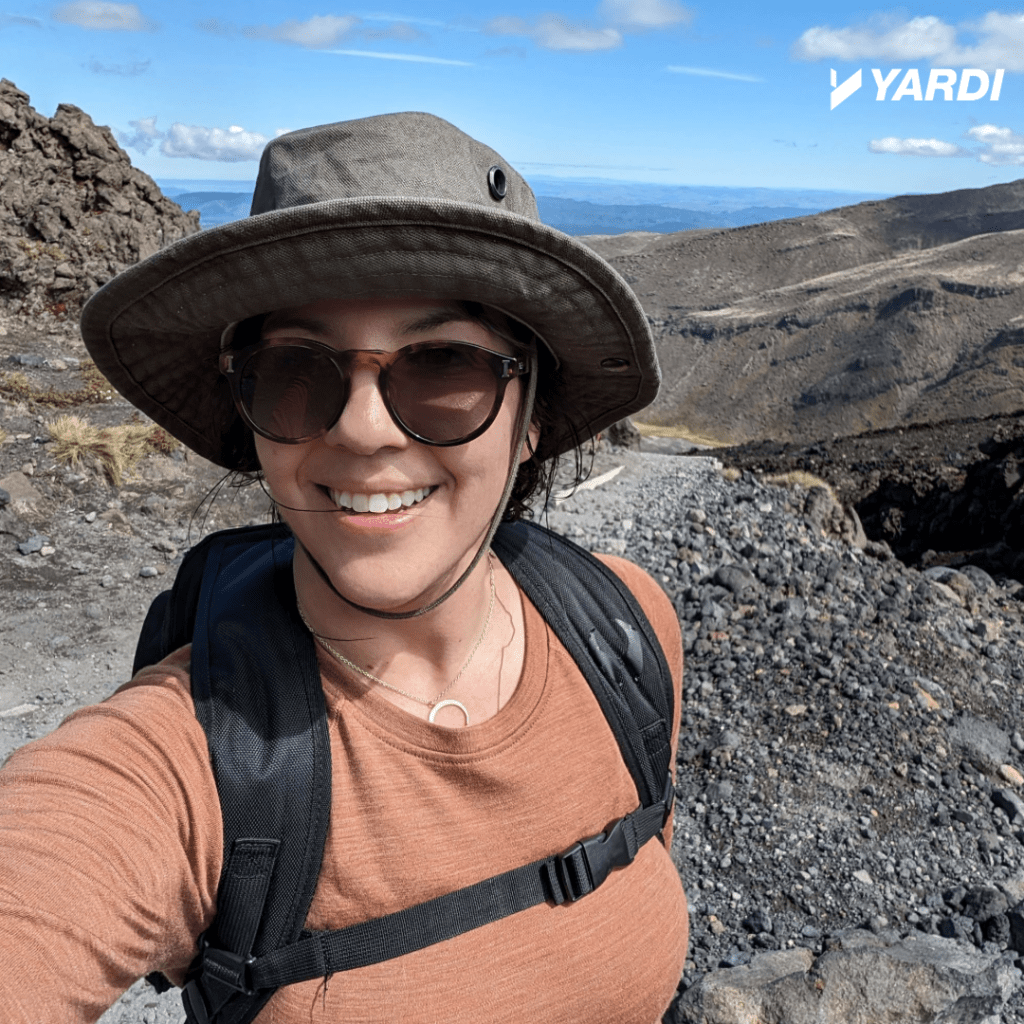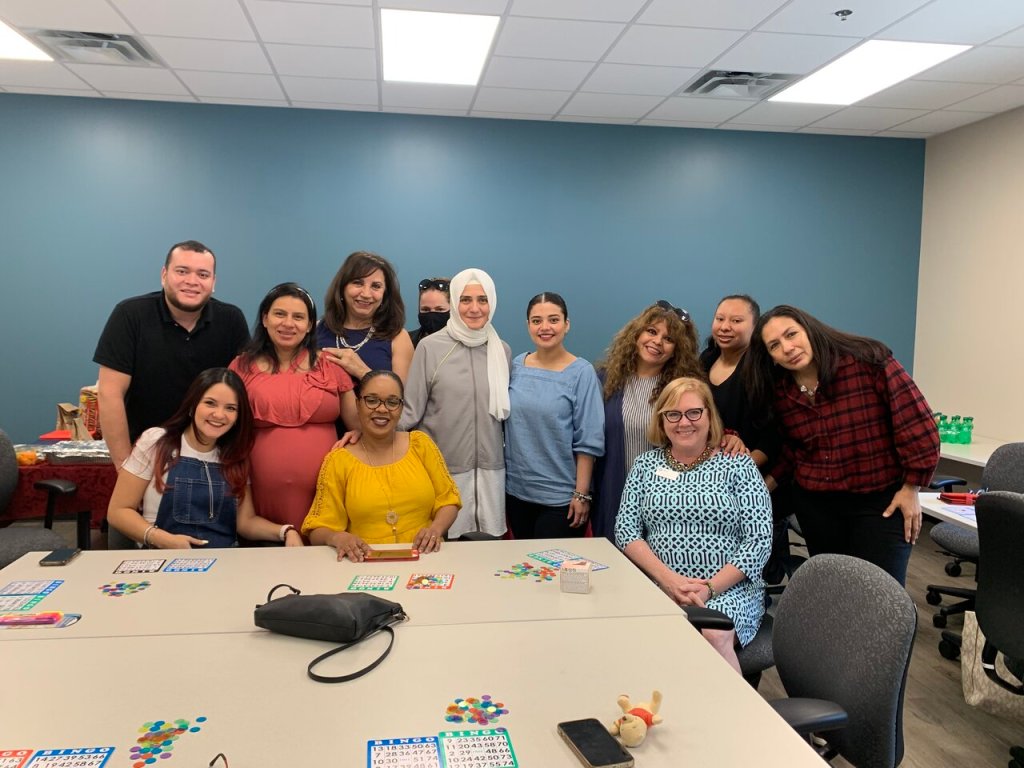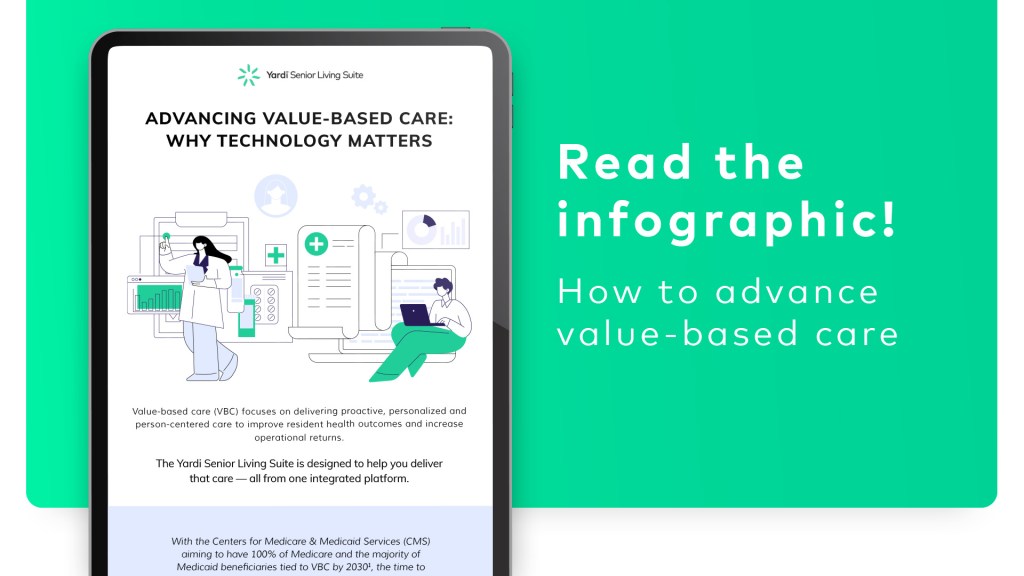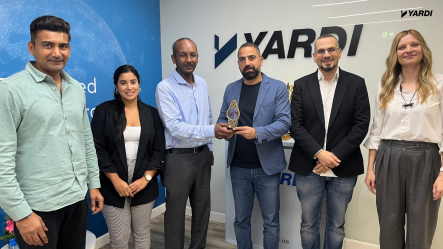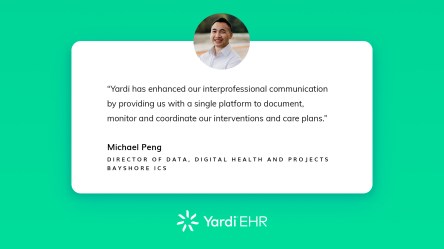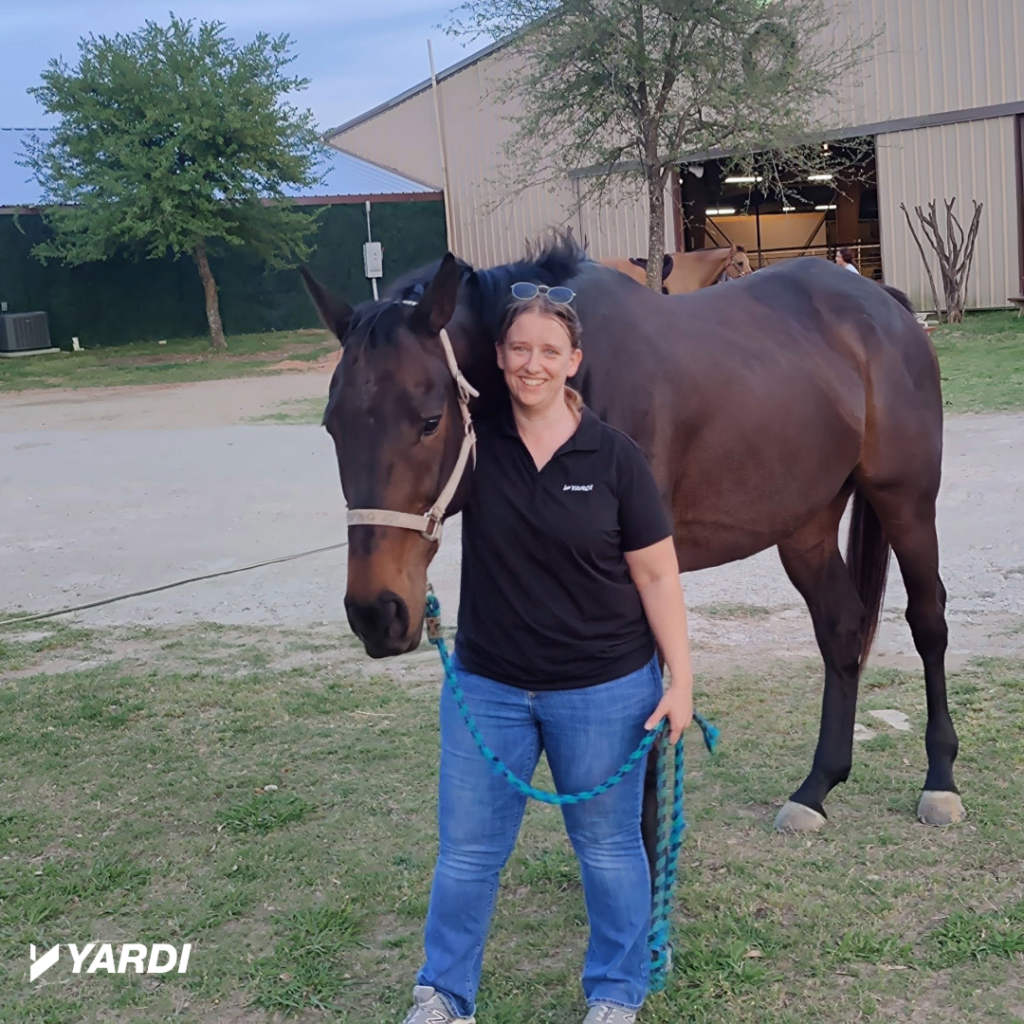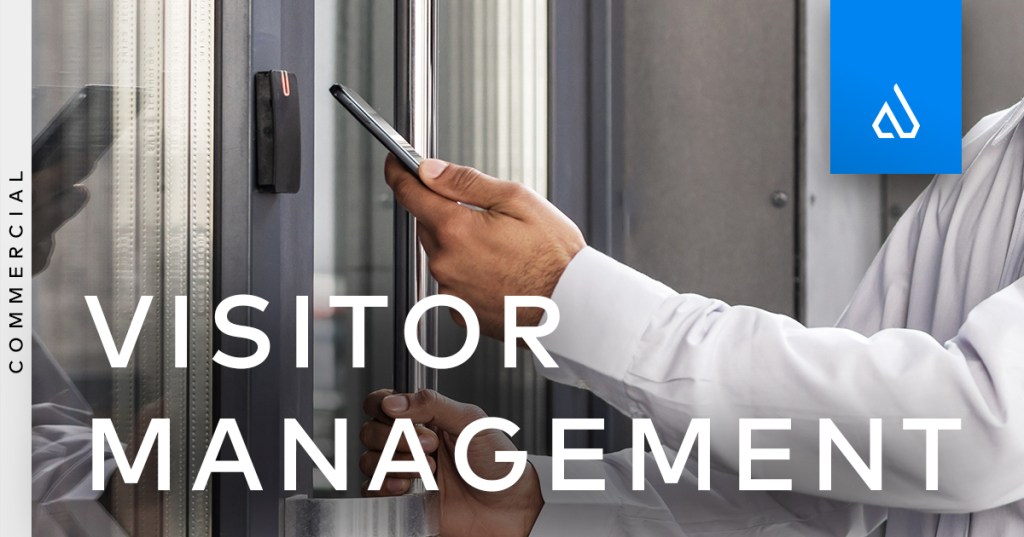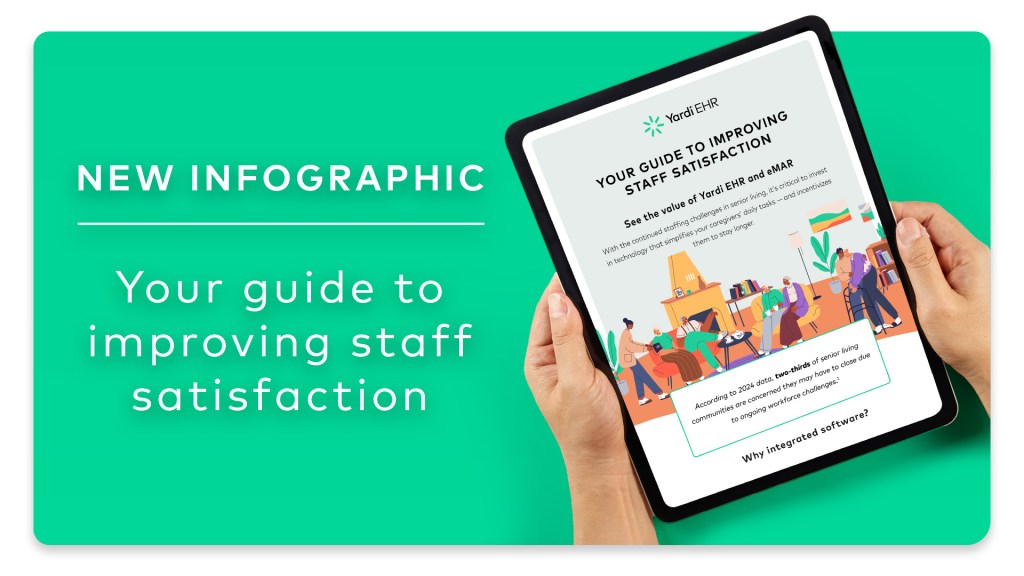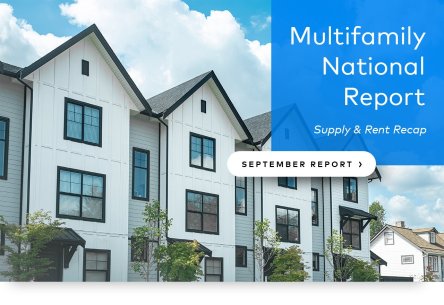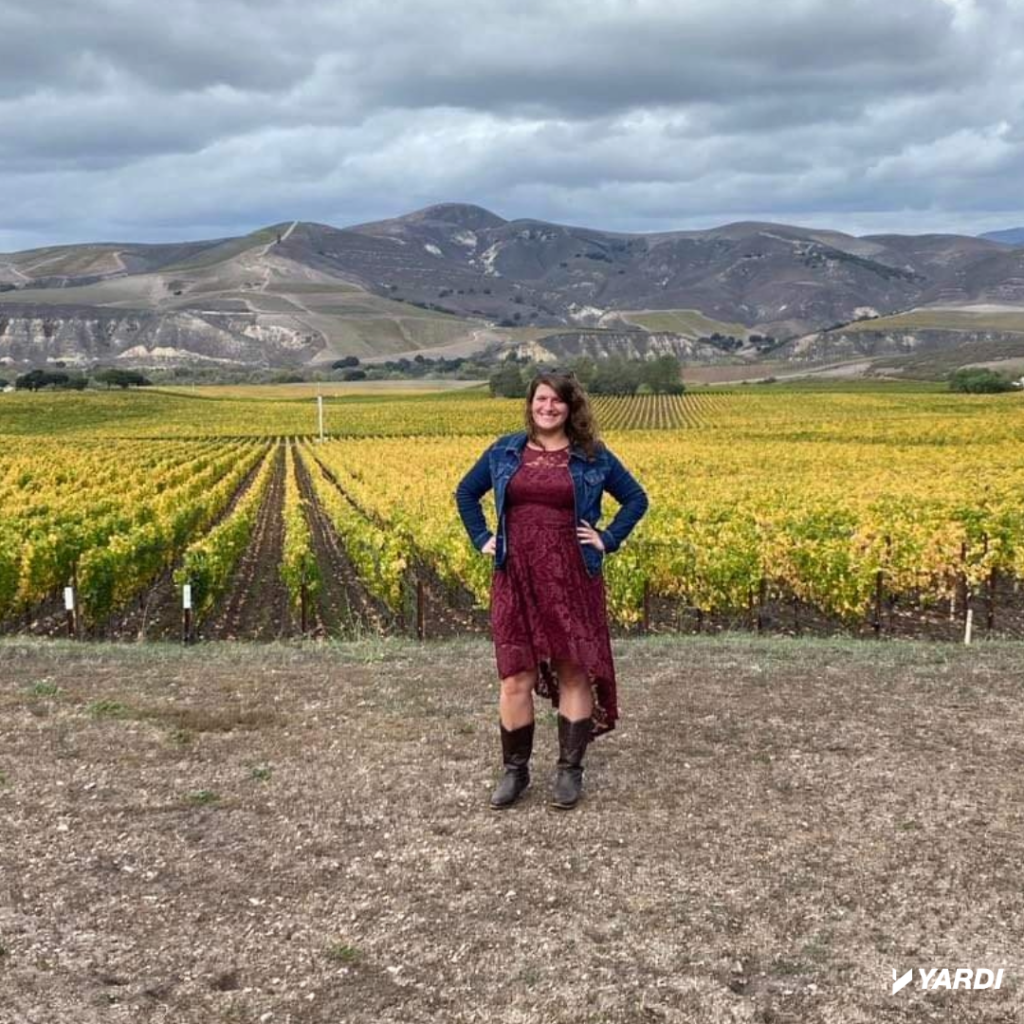Laura Sacks, a senior manager who works on Yardi’s investment management product suite, celebrates her fifth year at Yardi this November, giving her the benefit of four months in the office with colleagues before the world went remote during the pandemic. Yardi was Sack’s first corporate job, which she applied for with guarded optimism from referrals within the company and a dash of healthy skepticism since she is a relationships-oriented individual, so she was curious about how collaboration and connections would manifest in this space. She immediately found the spirit of exceptional generosity within the Yardi culture! “There is an energy of focused growth through the company that is achieved through discourse, creativity and collaboration that I find both energizing and inspiring,” said Sacks. Sacks spends her workdays working with clients, meeting with her team and developing special projects to facilitate growth and collaboration. Because Yardi, the products, and our clients constantly evolve, knowledge is forever growing. “I truly love how every day holds the potential for something slightly different from the day before and the ability to learn something new. Should you approach each day with a builder’s mindset and a willingness to say “yes” whenever possible, the opportunities for learning and growing at Yardi are endless,” exclaimed Sacks, her enthusiasm for continuous learning and growth shining through. Sacks reflects daily on advice about communication since her role is primarily about good communication and collaboration. She wants those to know that when communicating remember that clear is kind and unclear is unkind, “even if the topic is hard for you and/or the recipient, ambiguity is harder.” Evolving products Sacks prides herself on a project series of time-weighted performance calculations she built without knowing much about calculator analytics or time-weighted returns beforehand. “I appreciated the...
North Fulton Community Charities
Meeting Community Needs
This Yardi-supported nonprofit does it all! North Fulton Community Charities (NFCC) aims to help ease the hardships and foster financial stability in its communities. North Fulton Community Charities was established in 1983 in Roswell, GA, and serves over 9,000 residents in need in North Fulton County, including families. NFCC offers five programs of service to support both short and long-term economic stability: Rent/mortgage/utility assistance Client choice food pantry Clothing choice Seasonal support No-cost education and workforce opportunities By working with individuals through these programs, NFCC focuses on preventing homelessness by offsetting food, clothing, and seasonal costs. This ensures families can use those saved funds for other household expenses and provide opportunities to gain critical skills that lead to higher wages and better jobs. “Our priority is to offer programs and services that meet the community’s needs and will create the most meaningful impact for those we serve,” said Sherri Morgan, director of development for NFCC. Yardi’s funding has been instrumental in helping local at-risk families remain safely housed by providing direct rent, mortgage, and utility assistance. In 2023 alone, NFCC, with the support of Yardi, prevented homelessness and utility disconnection for 1,581 local families. NFCC’s team of caring case managers meets each family eligible for financial assistance and recommends aid to prevent evictions and utility disconnection while also providing critical referrals to other programs, both internal and external, to fill gaps in need. “Preventing homelessness is crucial to allow children to stay in school, allow parents to continue working, and stabilize families so they can access resources that will advance them on their journey to economic independence,” explained Morgan. In addition, the growth and success of NFCC’s programs are a source of pride for the community. With over 40,000 orders in the last year, the food pantry has saved users $4.7 million in grocery costs. The education program, NFCC’s fastest-growing program, has launched additional classrooms this year and two off-site to accommodate over one hundred adults on the waiting list for English classes. Now, the list is down to almost zero. NFCC’s commitment to removing barriers to its client’s resources by providing transportation and free child care to families is evidence of its dedication and impact. “We at North Fulton Community Charities are incredibly grateful to Yardi for their commitment to improving our community. Their generous contribution will ensure that North Fulton families facing financial hardship remain safely in their homes and are equipped with the tools they need to move toward greater financial stability,” said Morgan. Yana’s Ukraine Journey Yana came from Ukraine a year ago with her husband and three children after her husband secured work with an American logistics company. Escaping the war-torn country, she left a successful accounting business and arrived in the United States with little English. Yana was eager to enroll when she heard about NFCC’s English as a Second Language (ESL) program at her church. She began attending ESL classes in May 2023, and her family embraced English immersion. Yana moved quickly through the ESL classes and enrolled in NFCC’s GED program. The GED program allowed her to continue working on her English skills and earn her credentials to secure work. Even though Yana had earned a degree while living in Ukraine, a bomb hit her university in Ukraine, and all records were destroyed. Earning a GED would allow her to rebuild her life in North Fulton. On February 27, 2024, Yana earned her GED. Now, she is enrolled in classes at Interactive College of Technology and plans to return to working in accounting. “This GED program improves English vocabulary, and the atmosphere is very friendly. Thank you for your support at every step,” said Yana. Yana told NFCC program manager Wynona Kuehl that she is enjoying her new home. “It is similar to Kyiv, the motion of life and the comfort. The people smile and are friendly.” She also said, “I like...
New Nutrition Module
Yardi EHR
We’re excited to announce a brand-new nutrition module in Yardi EHR! This module was created based on feedback from our senior living clients. The nutrition module provides one intuitive place to see all nutrition intake — and output if applicable — for each resident. Streamline nutrition management with Yardi EHR In order to optimize care outcomes in senior living, you need to efficiently manage resident nutrition. With that in mind, we developed a brand-new nutrition module in Yardi EHR — our integrated, full-service electronic health record solution. The innovative module offers a centralized place to track all nutrition-related data for residents. Not only does this streamline workflows for food and nutrition staff, but it also empowers caregivers to provide personalized, effective care. At a glance, staff can view a resident’s dietary intake, BMI and weight gain or loss. They can also see a resident’s nutritional preferences, current dietary orders and allergies — all in one place. There’s the option to add meal and intake information, too, as well as output charting (if necessary). Learn why we developed this module It’s challenging for staff to track resident nutrition without dedicated resources. Caregivers have to navigate multiple modules — primarily the assessment and vital sign sections — to document dietary intake and preferences. Not only is this approach inefficient, but it also leads to confusion, since vital-sign templates get cluttered with unrelated data. This inspired us to create the nutrition module, which alleviates these challenges, streamlines nutrition management and improves resident care. Explore key features of the nutrition module The nutrition module consolidates vital information in one easy-to-access area, allowing you to: View resident intake at a glance — staff can quickly assess a resident’s dietary intake, weight fluctuations and BMI without sifting through multiple systems. This...
Workplace Workouts
Keeping Fit on the Job
Perhaps you’re spending more time in the office these days and lost your proximity to the gym or other favorite daytime workout location. But did you know that workplaces offer abundant opportunities for maintaining physical fitness? “Just because you have a desk doesn’t mean you have to sit at it for eight hours straight,” according to the American Heart Association. “Depending on your office situation, you could fit cardio and strength training into your workday,” adds Dr. Eric Moogerfeld, a physical therapist and athletic trainer with the Cleveland Clinic. “If you have to work at a desk, there are ways to make your desk work for you.” The AHA and other experts suggest: Moving around when you take a break rather than sitting in place. If you sit at a desk, stand up from time to time. March in place, or pace in a circle to keep moving. Alternate sitting and standing throughout the day with walking and stretching. Scheduling physical activity time on your work calendar – just like any other important appointment. Doing simple hand and finger stretches, abdominal stretches, seated leg extensions, oblique twists, chair calf raises and hip flexions. If possible, installing equipment such as bike desks, standing desks that support proper posture, treadmill desks, under-desk bicycles and ellipticals. Checking if your employer offers an onsite gym or exercise equipment. Maintaining an ergonomically sound workplace. “Whether it’s five minutes or an hour of movement, there are real health benefits to any type of activity during the workday,” says Sandy Todd Webster of IDEA Health & Fitness Assn., a San Diego-based fitness and wellness professional organization. “If you are able to walk or power yourself forward by some means, do it. You don’t need a gym. Movement opportunities are...
Risks and Rewards
Yardi Matrix Multifamily Webinar
Yardi Matrix vice president Jeff Adler again delivered a master class on the current state of the multifamily sector during an Oct. 23 webinar. The recording and presentation slides are available to view online. Multifamily is experiencing robust performance despite a significant influx of new supply, particularly in the Sun Belt and Mountain West regions. Although advertised asking rent growth for new leases has softened—often turning negative—units are still being absorbed. Overall, most markets are experiencing a healthy three to five percent growth in both occupancy and renewals. “The multifamily industry has really performed quite well given the unbelievable amount of new supply that’s been coming in,” Adler said. In the top 20 markets tracked by Matrix analysts, the multifamily sector is grappling with substantial new supply, with approximately half a million units set to be delivered this year. Renter-by-necessity units (Class B to C assets) are now outperforming lifestyle units (Class B+ to A assets). This is largely due to the nature of new construction, which tends to cater to the higher end of the market. This has led to some challenges for owners of lifestyle properties, as the influx of new supply dampens their performance. Retention rates are returning to pre-pandemic levels, largely driven by affordability issues in the single-family home marketplace. This trend suggests that many renters are opting to stay put, contributing to a higher number of positive renewal lease trade-outs, even in markets experiencing rent declines. This trend highlights the critical role housing affordability plays in the current market landscape. Adler discussed some of the specific challenges for affordable housing supply in great detail – tune in to the recording for more insights. The bottom line is that more housing will need to be constructed to resolve the nation’s affordable housing problem. Fewer new stock deliveries are expected in 2026 and 2027, which means the stage may be set for a potential spike in multifamily rent growth, Adler forecast. An overarching shortage of U.S. housing is unlikely to improve in the next five to ten years, suggesting a strong investment thesis for multifamily housing. As capital costs normalize, transaction activity is expected to increase. While some distress may appear in specific areas, the multifamily sector remains resilient and poised for continued long-term growth. In a new format for Matrix, the webinar also included identification of potential investment opportunities and a comprehensive look at the state of the economy. Listen to learn more. “The economy is pretty healthy at a macro level. But there are cracks in the economy emerging, and at some point, those cracks have to come to fruition and be resolved,” Adler...
Advancing Value-Based Care
Why Technology Matters
With the Centers for Medicare & Medicaid Services (CMS) aiming to have 100% of Medicare and the majority of Medicaid beneficiaries tied to value-based care (VBC) by 2030, the time to implement VBC is now. Explore our new infographic to see how the Yardi Senior Living Suite helps you seamlessly deliver VBC — all from one integrated platform. See how the Yardi Senior Living Suite supports VBC Enhance communications among residents, families and the entire care team. Gather data-driven insights to identify at-risk residents and offer preventative care. Empower staff with interoperable workflows, personalized to meet resident needs. Support community wellness programs that boost resident engagement. View actionable trends to ensure comprehensive population health management. Access a digital signature workflow to enable quick adaptation of care plans. Use health care data to report on resident status during transitions of care. Participate in value-based care reimbursement models. Share a cohesive picture of resident health with physicians, health systems and more. Connect to a thriving ecosystem of monitoring and fall detection systems to supplement staff observation and reduce adverse events. Take a closer look at our fully integrated tools The Yardi Senior Living Suite combines resident care, marketing, sales, finance, business intelligence, pharmacy, operations and more on a cloud-hosted, HIPAA and SOX-compliant software platform. As it relates to VBC, you can: Enable real-time information sharing with Yardi EHR, our full-service electronic health record solution. Access clinical trends and population health with Yardi Senior IQ, our comprehensive business intelligence solution. Improve resident engagement with RentCafe Wellness, our dynamic wellness management solution. Hear from our partners “Senior living operators need tools that allow them to communicate proactively as an integrated team with care providers, patients and families to be successful in value-based care,” explained Amy Kaszak, executive vice president of strategic initiatives at Curana Health. “This means that they need technologies that integrate across the continuum and that enable workflow-based alerts and processes.” “We appreciate Yardi’s efforts to advance the technology needed to support the senior living industry’s move to value-based care,” shared Alan Fairbanks, president of the value-based care alliance at Serviam Care Network. We’re here to help Ready to chat with team Yardi? Reach out to book a meeting. We’ll share more on how our single connected solution supports...
Médecins Sans Frontières...
Doctors Without Borders
Yardi-supported nonprofit Médecins Sans Frontières (MSF) was established in 1971 with headquarters around the EU, including Paris, Barcelona, Athens, Brussels, Amsterdam and Geneva. The organization provides medical assistance to people affected by conflict, epidemics, disasters or exclusions from healthcare. Its teams comprise thousands of health professionals, logistics, and administrative staff, most of whom are hired locally. Medical ethics and impartiality, independence and neutrality guide its actions. MSF has a future focused on addressing the escalation of humanitarian crises, particularly in Sudan, which demands its full attention. It is also deeply committed to ongoing emergencies in regions such as Palestine, Lebanon, and Yemen, where healthcare access is limited. Additionally, MSF continues to advocate for these underreported and forgotten crises, ensuring that those affected receive vital medical care. “Our priority remains to be on the front lines where the need is greatest, regardless of media coverage or visibility,” said Angelly Cabrera, partnership manager for MSF UAE. Funding from Yardi is not just critical; it’s transformative. It enables MSF to respond to crises, especially during the most challenging and unpredictable moments. The sustained support from Yardi allows MSF to plan and act quickly, ensuring that it is on the ground where and when they are needed most. This is not just about funding that makes a difference. It’s about the belief in MSF’s mission and trust that drives them forward. Yardi’s support is not just a contribution. It’s the power of collective action and the difference we make when we stand together. “One of the greatest strengths of this partnership is the trust that Yardi has placed in our field teams, which is vital for maintaining the independence that defines MSF. This independence empowers us to prioritize medical care based on needs alone, without being influenced by political or...
Romanian Maltese Relief Organization
Asociatia Serviciul de Ajutor Maltez in Romania
The Romanian Maltese Relief Organization is a Yardi-supported non-governmental association that, during its 33 years of activity, has contributed to changing the destinies of thousands of people in difficulty. This organization was founded in 1991 in Cluj-Napoca, Romania and is defending the faith and helping those in need by continuing to be involved in the community and offering the needed help. When it started its services, the Romanian Maltese Relief Organization aimed to assist children, and now it boasts of recovered young people and adults who are helpful to society. It also provides a social program called Maltese Kindergarten, a daycare for children with neuromotor disabilities. During its years of activity, the Maltese Kindergarten offers education and recovery services to more than 400 special children, many of whom have become independent adults today. The daycare has been certified as a Psychology Structure by the Romanian College of Psychologists. It has been licensed by the Ministry of Labor and Social Solidarity as a social service center since 2005. It has a team of six therapists dedicated and committed to the love of the children, primarily exclusive specialists, psychology graduates, psychological counselors, unique psych pedagogy and physical therapists who have all been certified by the Romanian College of Psychologists. Early personalized therapy can help these children to have a chance for recovery, discover life independently and even go to school. Through its daycare center, the Romanian Maltese Relief Organization provides education and recovery services from an early age. “It is difficult to imagine being a parent of a child that is living with a disability. It is even harder to imagine being a child with disabilities. You couldn’t explain to your mother what hurts you, you couldn’t reach out for your favorite toy, or you couldn’t eat chocolate. These are all simple things that make the difference between living and existing,” explained Mirela Codreanu, director of Romanian Maltese Relief Organization’s Maltese Kindergarten. This year, the Romanian Maltese Relief Organization has opened the first inclusive Playground in Cluj-Napoca, a playground to which Yardi funding contributed in 2023 and 2024. This playground is a first of its kind and, through its attractive and complex design, will bring together children with and without disabilities. This concept was created through Symphony of Friendship, another beloved social project. Its goal is to ensure children with physical and mental disabilities have equal rights to approach public spaces for relaxation and play and to encourage inclusion through play. “This project is important to us because it can contribute to changing mindsets, open opportunities, and new ways to see the vulnerable. We dream about a society that is more tolerant and helpful with those who have a disability, a society that stops pushing away the different ones but embraces it,” said Codreanu. In addition to the playground, Yardi funding helps continue the charitable work at Maltese Kindergarten, allowing the Romanian Maltese Relief Organization to create a safe space for any child who needs special education and recovery. This benefits the less fortunate, special and vulnerable children. “We managed to be that much-needed support, thanks to your implication. I want to encourage you to turn your attention to these programs for special children because you help us support those in much need,” expressed Codreanu. Raul’s Pathway to Hope Cheerful, shy six-year-old Raul had social, motor and communication barriers before he came to Maltese Kindergarten. When he arrived, his diagnosis reflected the fact that he did not walk, speak, eat, and did not understand anything. However, shortly after his adventure started as a “Maltese” child, he gradually managed to explore every corner of the house. First, he crawled, and then, with help from a walker, he soon found himself able to walk after one year of physical therapy. With patience and perseverance, Raul became more receptive to those around him, learning new words and understanding others. After the first year, he...
OWCAP
Creating Positive Change
OWCAP helps people help themselves and each other. Yardi-supported nonprofit Ogden-Weber Community Action Partnership, Inc. (OWCAP) was established in 1965 in Ogden, Utah. It is working to elevate individuals and families in Weber County through services and collaboration. OWCAP is a part of the National Community Action Network, created under President Lyndon B. Johnson’s War on Poverty. Its current programming includes Head Start and Early Head Start programs, Circles of Weber County, Volunteer Income Tax Assistance (VITA), Roy Communities that Care (CTC), landlord/tenant mediation and housing education, and education/employment assistant services. Being a Community Action Agency means embodying the spirit of collaboration through strong community partnerships. These partnerships with local organizations, businesses, and residents are crucial to its work. They help address and respond to the community’s ever-changing needs and make community members an integral part of its efforts. It involves a commitment to understanding and adapting to the unique challenges and opportunities within the community, leveraging collective resources and expertise to create effective and sustainable solutions. “By fostering these dynamic partnerships, we remain agile, responsive, and impactful in improving the quality of life for our community—helping people and changing lives,” said Christine Ipsen, executive director for OWCAP. OWCAP focuses on improving programs by improving the overall health and well-being of participants and staff, prepares children and families for kindergarten and future education success, empowers low-income clients to increase self-sufficiency and operates as an influential, innovative organization that is an asset to low-income communities. Its strategic goals behind the programs include expanding the capacity of current programming, implementing a communication plan to include branding and advocacy, supporting staff by providing a model working environment and being a collaborative partner in meeting the community needs. Community Action Agencies also have a Community Action Plan (CAP...
Yardi EHR Success
Hear From Bayshore ICS
“Yardi has enhanced our interprofessional communication by providing us with a single platform to document, monitor and coordinate our interventions and care plans.” We recently interviewed Michael Peng — director of data, digital health and projects at Bayshore Integrated Care Solutions (ICS) — to get insights like the one above. Peng and his team shared how Yardi EHR (and additional solutions in the Yardi Senior Living Suite) have transformed Bayshore’s operations for the better. Read the success story to see Bayshore’s transformative journey, including where they are today. The Challenge: Inefficient Paper Processes Bayshore ICS previously used paper processes that were time consuming, susceptible to errors and difficult to maintain. Paper workflows also meant information was scattered across locations — and wasn’t easily retrievable — risking inconsistencies that could affect resident safety. Bayshore ICS sought a single connected solution that would centralize everything needed in one secure place. The Solution: Yardi EHR Yardi EHR is an integrated, interoperable electronic health record solution designed for senior living. This single connected solution combines the clinical intake process, medication management, charting, behavior management and more on a browser-based platform. The Story: Centralizing Workflows, Saving Time & Empowering Staff Before Yardi, Bayshore ICS relied on paper for charting, assessments, medication management and more, which brought an array of challenges. Not only was there a lack of standardized practices across TCU locations, but paper also made it difficult to store and retrieve information, evaluate the clinical effectiveness and complete audits. Not to mention, paper workflows posed challenges for supporting care remotely. The obstacles paper workflows created didn’t stop there. Communicating information across teams wasn’t optimal, causing staff members to feel siloed. Communication during emergency transfers was particularly inefficient since caregivers had to manually transcribe data or photocopy charts. Since...
Early Tech Showcases
World’s Fairs Through the Centuries
World’s fairs – international exhibitions of industrial, scientific and cultural advances held at a specific site for several months – boast centuries of history as forums for transformative technologies. The largest steam engine ever built, the telephone, the typewriter, the mechanical calculator, the Ferris wheel, a prototype fax machine and the Ford Mustang are just some of the inventions showcased at world’s fairs. In 1893, alternating current powered the World Columbian Exposition in Chicago, leading to the widespread use of electricity in homes and businesses. World’s fairs also helped “instill confidence in a public still getting used to the idea that many of the goods they use every day were now being made using machines, rather than by hand,” according to Elizabeth Yuko, an adjunct professor of ethics at Fordham University. The modern era of world’s fairs launched in 1851 with the Great Exhibition of the Works of Industry of All Nations in London, 60 years after the first industrial exhibition in Prague. Since then, more than 100 world’s fairs have been held in more than 20 countries. The U.S. Centennial Exhibition in Philadelphia, the first held in the U.S., drew almost 10 million attendees in 1876. Many fairs also featured art, entertainment, cultural exhibits and rides. Fairs have often taken place against a backdrop of futuristic new structures such as the Eiffel Tower, at the time the world’s tallest tower (Paris, 1889); the Atomium (Brussels, 1958); the Space Needle (Seattle, 1962); and the Unisphere (New York City, 1964). Some fairs, such as those in Brussels and Montreal (1967), gave Cold War rivals a stage for space hardware and other advanced technology. (Although generally classified as a world’s fair, the 1964 event was not sanctioned by Paris-based Bureau International des Expositions, which governs and...
Paper to High Tech
The Evolution of Passports
If you travel internationally, you must have a passport. One hundred sixty-one million holders of valid U.S. passports take that fact for granted, but this document took centuries to evolve from a frill into a mandatory border-crossing asset. The modern era of passports began when Louis XIV, king of France from 1643 to 1715, issued favored citizens a “passe port” signifying “approval to pass through a seaport.” American passports in the late 1700s were also reserved for select constituents. “The most famous early U.S. passports were issued by Benjamin Franklin when he was U.S. representative in France in the late 1780s,” says Craig Robertson, author of The Passport in America, and mostly served as “letters of introduction that verify the character of the person bearing them.” Passports in the 19th century typically comprised single-sided pages containing the bearer’s name, age and other basic identification. They were often utilized for single trips. Cities and notaries public could issue them until 1856, when Congress made the Department of State the sole issuing authority. By the late 1800s, “U.S. passports were becoming more mainstream, but they were still considered more of a travel perk for the holder than a requirement to cross borders,” says Jessica Puckett, a transportation and travel writer for Condé Nast Traveler. Setting a global standard In 1920, the League of Nations proposed a worldwide passport standard, introducing the modern format of a small booklet with pages for stamps. By 1926, American passports started to resemble today’s model: pocket-size booklets with multiple pages and durable material. By 1952, all American citizens were required to have passports to depart from or re-enter the United States, except for certain countries in North America and Latin America. Their shelf life increased from two years to three in 1959, to...
Regan Heydari
Yardi Employee Profile
Yardi’s global offices are crucial in property management and investors worldwide. Today, we introduce you to Regan Heydari, the Global Solutions Commercial TX practice team director at the forefront of this global mission. Meet Regan Heydari Regan Heydari, a key individual at Yardi for the past 13 years, holds a pivotal role in the Commercial support of the central region. Her responsibilities include leading a dynamic team that is committed to delivering top-tier support to Yardi’s commercial clients. Her multifaceted role involves strategic planning, problem-solving, and ensuring clients receive the highest quality service. “Over this time here at Yardi, I’ve seen the company grow and evolve, and I’ve had the privilege of contributing to its success,” said Heydari. Heydari spends her workdays with a blend of client interactions and team collaboration. Her most significant time is spent assisting clients with their needs and challenges while supporting and mentoring a team to ensure they deliver exceptional service. Energized for Good Heydari loves the variety of her day, which energizes her, “Every week brings new challenges and opportunities to work with different people. This constant change keeps my job exciting and fulfilling,” explained Heydari. Yardi’s unwavering willingness to help and collaborative culture make it an inviting workplace. No matter who reaches out, someone is always ready to jump in and collaborate on solving a problem. New hires can look forward to a supportive workplace filled with passionate individuals and a place where contributions are valued. “The spirit of teamwork and mutual support is truly remarkable,” expressed Heydari. Yardi is hiring globally! Interested prospective employees can explore opportunities on the Careers site. Game-changing success Direct focus on one task at a time instead of multi-tasking has been a game-changer for Heydari’s productivity and effectiveness. Heydari is proud to...
You’re Welcome
Visitor Management Software
If you’re in CRE, you already know the challenges of managing and tracking visitor access at your properties. You need to know who is entering and for what purpose, how long they stay and when they leave. This can place a burden on site reception teams and can also lead to a frustrating experience for visitors who must wait for authorization to gain access including for scheduled appointments. New tech makes this process easier for everyone and reduces risk through automation and tracking tools for reporting purposes. Whether you’re an owner or landlord, building manager or corporate occupier, a visitor management solution (VMS) provides a welcome experience for short-term visitors, event attendees, contractors and staff. Connect people and buildings Wondering exactly how a VMS can help your building operations and the people you interact with at your sites? If you’re a landlord or owner, you can deliver a smarter building to attract the best tenants. A VMS such as Yardi Bluepoint can increase retention by providing a great experience for those working and visiting, plus you can analyze visitor data for oversight of your portfolio and its utilization. Building managers can predict staffing requirements to maximize reception utilization and manage visitor volume. For increased security, managers can configure access permissions for tenants and visitors. Corporate occupiers can empower staff to create branded appointments, view pre-visitor information and receive instant notifications when their visitors arrive. Here are some key benefits to consider: Faster check-in: shorter wait times and instant arrival notifications. Flexible visitor management: time-limited access with this easy-to-use software. Visitor appointments can be created using the calendar app or website portal. Contactless check-in: with Bluepoint, visitors can be checked in by site receptionists through the portal or via a kiosk with QR code, PIN or name. Enhanced security: building managers can proactively manage visitor flows and configure access permissions for tenants and visitors. It also provides additional layers of building security. Customizable experience: corporate occupiers can create branded visitor invites, request pre-visit information and receive instant visitor arrival notifications. Real-time visitor data: staff, tenants, reception teams and building management can access real-time visitor data for strategic decision-making on staffing, space utilization and compliance. Yardi Bluepoint value adds Oversight with real-time data: Bluepoint provides actionable insights to enable safer and more efficient management of your spaces. It helps you stay up to date with planned visitors and keep account of drop-in visitor numbers. You can plan for reception services, security and visitor amenity requirements by reviewing Bluepoint data. Tenant empowerment: Bluepoint allows you to manage access permissions for meetings and events and enables your tenants to book time-limited appointments by visitor type. It can integrate with existing tenant management software to provide a seamless experience. Bluepoint is compatible with all calendar apps, so visitors can be invited directly from any calendar including Outlook and Gmail on a desktop or mobile device. Security and compliance: Bluepoint is GDPR compliant and helps you stay current with visitors in your building for critical security and compliance. It provides an accurate overview of who is where and at what time in your building with a check-in and check-out process. You can implement additional security with time-limited, temporary access passes for visitors and staff. Contactless access: Bluepoint allows for smart access using existing access control with a mobile QR code or access card. Activated Bluepoint QR codes can be used with speed lanes, elevators and even meeting rooms. It facilitates contactless check-ins with a free-standing or desk-mounted kiosk. Easy to integrate: Bluepoint’s fully featured API allows for smart connections with new and existing building management technology. Access control integrations with leading manufacturers and tenant engagement platforms allow for an improved experience. Ready to connect people and buildings to optimize operations and satisfaction? Learn more about Yardi...
Improve Staffing Satisfaction
With Yardi EHR & eMAR
With the continued staffing challenges in senior living, it’s critical to invest in technology that simplifies your caregivers’ daily tasks — and incentivizes them to stay longer. Explore this quick but comprehensive infographic to see exactly how technology can help you. Why integrated software? Paper processes are time-consuming and error-prone. Technology can help, but not when solutions are siloed and housed on different platforms. The burden these options create translates to staff feeling unsupported and overwhelmed, which leads to high turnover. Integrated software equips caregivers to view resident information, complete daily tasks and manage communications in one place. There’s no need to devote energy to arduous, manual administrative work, which allows them to focus on what matters most: resident care. With Yardi EHR and eMAR — fully integrated tools — you alleviate caregivers’ burden and boost satisfaction and retention. Why Yardi EHR? Gain executive health care oversight with clinical reporting, centralized resident records and instant access to financial data. View real-time health information and utilize convenient workflows, readily available at the point of care. Channel interoperability through verified interface partners that allow data to flow to and from Yardi EHR automatically. Free more time for residents with simplified record keeping, easy information sharing and reduced data-entry tasks. Utilize customizable dashboards and reports to easily manage resident care and optimize health outcomes. Access comprehensive clinical data and a staffing analysis workflow when you pair Yardi EHR with our business intelligence solution, Yardi Senior IQ. Why Yardi eMAR? Use an intuitive, customizable dashboard and workflows that adhere to state regulations and promote compliance. Reduce paper documentation, processing time and expenses with web-based records that eliminate manual medication administration tracking and medication reconciliation. Enhance care with a centralized platform for documenting vital sign data, lab orders, treatment plans and more. Incorporate automated billing based on medication orders and integrate financial analytics with medication administration. Gain a competitive edge with access to a growing market of pharmacy providers that have joined the Yardi Pharmacy Network. Eliminate discrepancies between care plans and medication administration, helping optimize staff shift assignments. Your success is our priority With Yardi, you can power your workforce strategy from a single platform. Reach out today to get...
Abandoned America
Historic - and Haunted? Ghost Towns
It’s the season to be a little spooked with thrills and shrills! Let’s explore why some cities in America have become ghost towns, and if being drawn to the mystery piques your interest, gather with some friends and uncover some real estate mysteries this fall. Many abandoned cities in America are due to the Gold Rush and industrial sites founded in the Gilded Age. Some began as lucrative mining communities that vanished almost overnight, and some are victims of new railways and infrastructure. Others were hit with natural disasters like tornados that flattened out the entire town. Hollywood movie producers and writers have been inspired and even filmed in a few. Pennsylvania. Being one of the most populous states in the country, Pennsylvania is home to many ghost towns and abandoned cities. On the western side of the state, in a suburb of Pittsburgh, Lincoln Way is an eerie little abandoned neighborhood that has become an attraction for urban explorers. Legend states that a “Beast of Lincoln Way,” a mysterious creature with glowing eyes and a haunting howl, terrorized residents, leading to the abandonment of the homes. In reality, it’s gloomier, with most residents moving away due to pollution from the emissions of the steel plant and older residents passing on. Still, many fascinating stories date back to the early 1900s, and in its final days, it is indeed an eerie, post-apocalyptic street. In eastern PA, Centralia was a thriving coal-mining town, but now, only a handful of people live there, mainly due to the coal mine that caught fire in 1962. The coal seen fueling the fire is expected to last another 250 years. This burning ghost town would not have even been recognized had it not been the inspiration for the 2006 horror...
Multifamily Update
From Yardi Matrix
Seasonality and supply are tempering advertised asking rent growth but demand remains strong, according to the latest Yardi Matrix National Multifamily Report. The average U.S. advertised asking rent decreased by $3 in September to $1,750, flat at 0.9 percent year-over-year (YoY). Occupancy stood at 94.8 percent in September, unchanged YoY. Gateway markets in the East and secondary markets in the Midwest continue to lead in YoY advertised asking rent growth, run by New York City (5.4 percent), Kansas City (4.2 percent) and Boston (3.4 percent). Supply increases continue to pressure asking rents in many Sun Belt metros, and the largest declines YoY were posted by Austin (-4.9 percent), Raleigh (-3.1 percent) and Phoenix (-2.4 percent). Post-pandemic demand has led to 1.7 million multifamily units absorbed between March 2020 and August 2024. All 132 markets surveyed experienced positive absorption, with Dallas (108,000 units) and Houston (71,000 units) in the lead. Single-family rentals advertised asking rents decreased $3 in September to $2,167, for a 0.6 percent YoY increase, with Kansas City (4.7 percent YoY) and Indianapolis (4.3 percent) posted the strongest growth. SFR occupancy declined 30 basis points to 95.3 percent in August. Gain more insight in the new Yardi Matrix National Multifamily Report. Yardi Matrix offers the industry’s most comprehensive market intelligence tool for investment professionals, equity investors, lenders and property managers who underwrite and manage investments in commercial real estate. Yardi Matrix covers multifamily, affordable housing, student housing, vacant land, industrial, office, retail and self storage property types. Email [email protected], call 480-663-1149 or visit yardimatrix.com to learn...
Will Frequencies
Become Rare?
Some observers consider radio frequencies the world’s most valuable natural resource and worry they could be depleted in the manner of other finite resources like clean air and water. Applications ranging from radio and television to cell phones, military systems, GPS and Wi-Fi use frequency bands of radio waves, a portion of the electromagnetic spectrum that includes microwaves, infrared, visible light, ultraviolet, x-rays and gamma rays. The use of radio frequencies by government and private entities is governed by the International Telecommunication Union (ITU), an international regulatory authority, and national authorities including the U.S. Federal Communications Commission. Frequencies are “the very foundation of all our wireless communications, and without them our modern life wouldn’t be possible as we know it,” says Swedish tech company LumenRadio. Flexibility from new tech But with billions of wireless devices currently in use and being developed rapidly filling up the frequencies allotted for commercial usage, could we run out of space on the radio frequency spectrum? “Yes, if you consider the number of white spaces and the limitations of existing technology to breach the high frequency barrier,” asserts ScienceABC.com, a repository of science facts. But exhaustion of this resource might not be imminent. Researchers are developing ways to utilize white spaces – frequencies that go unused to provide a buffer between radio signals that prevents interference – more effectively. New technologies for transmitting and receiving signals could eliminate both interference and the need to separate frequency bands. And some experts, such as internet pioneer and former MIT professor David Reed, are skeptical of the whole notion of a finite electromagnetic spectrum. “No single action is a silver bullet when it comes to meeting mobile capacity needs,” according to former FCC official Neil Grace. “More efficient use of spectrum, new...
Sam Valdés
Yardi Employee Profile
Yardi Aspire has grown exponentially and now offers over 1300 titled courses, much of which is due to Sam Valdés, manager for Yardi Aspire from the Santa Barbara office. Meet Sam Valdés Sam Valdés, celebrating her eighth year at Yardi in December, is a shining example of dedication. Her teams with Yardi Aspire write and produce the courses, videos and other content assets available in the Aspire product. Most videos are available in Client Central and/or product Help documentation. Valdés spends most of her time supporting team members as they work on content projects through one-on-one meetings, group brainstorming, and reviewing storyboards or course designs. Valdés enjoys working with clients on their training needs and has formed significant partnerships over the years. “It’s always a pleasure learning from the people who use our product daily,” said Valdés. In addition to working with clients, Valdés enjoys helping our clients’ employees build knowledge and skills. “What we offer can assist people with feeling more confident in their work, growing as individuals, and advancing in their careers. It’s rewarding to know we offer value not only at the organizational level but also at the individual level,” explained Valdés, underscoring the profound impact of her work. Take Care of our Employees Valdés appreciates that Yardi genuinely strives to fulfill its company motto—to take care of our clients, employees, and communities. This attitude of taking care of each other shows up in the approach to teamwork across the organization. “In my role, I’m uniquely positioned to work with dozens of product teams in multiple markets, and everyone is always willing to help each other. In the end, we know we’re team Yardi, and whatever we can do to benefit each other benefits everyone, including our clients,” said Valdés. When...
RAD Camp
Rising Above Disabilities
RAD Camp, a Yardi-supported nonprofit organization established in 2014 in Irvine, Calif., is a testament to the power of community support. It rises above disabilities for adults and children with developmental disabilities, serving all developmental disabilities from autism, Cerebral Palsy, Down Syndrome, and more with its programs and overnight summer camps. This life-changing volunteer experience for the community is a collective effort that encourages independence, growth, and, most importantly, fun! “Based in Orange County, our nonprofit hosts the largest and most affordable overnight summer camps for individuals with developmental disabilities in California,” said Meghan Clem, co-founder of RAD Camp. RAD Camp owes its success to the over 700 volunteers who support this predominantly volunteer-run nonprofit. Most of its counselors, between the ages of 16 and 25, play a crucial role in providing a much-deserved break for caregivers. Their dedication and commitment ensure that RAD Camp is the only option for consecutive respite nights in a calendar year. “We believe that by offering young people this life-changing experience, we contribute to creating compassionate and capable young community members,” said Clem. Funding from Yardi goes towards the general operation of RAD Camp. The contribution helps cover access to its 24-hour on-site medical care, provides campers with three meals a day plus snack time, special diet accommodations, RAD Swag (including themed T-shirts, water bottles, and backpacks), daily programs and activities, nightly team-building exercises, housing, and security. Though the actual cost per camper is high, RAD ensures every camper receives a sponsorship and pays the registration fee. However, for those with financial constraints, RAD does not hinder families from joining and will cover the total amount if a camper cannot give the requested fee. “We could not be more thankful for the support received from Yardi! Any donation...

